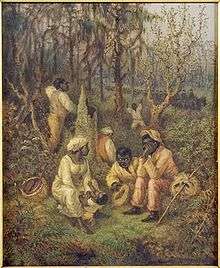David Edward Cronin
| David Edward Cronin | |
|---|---|
 Fugitive Slaves in the Dismal Swamp, Virginia, 1888, oil on canvas | |
| Born |
July 12, 1839 Greenwich, New York, US |
| Died | June 9, 1925 (aged 85) |
| Other names | Seth Eyland |
| Occupation |
|
| Known for | Düsseldorf school of painting |
David Edward Cronin, also known by his pseudonym Seth Eyland,[1] (12 July 1839 – 9 June 1925) was an American painter, illustrator and journalist.
Life and career
Early life
Cronin was born in Greenwich, New York.[2] He was a childhood friend of President Chester A. Arthur.[2] After studying the arts in Troy, New York, he moved to New York City in 1855. He spent the years from 1857 in Europe, where he probably studied for one year at the Kunstakademie Düsseldorf. He is considered a member of the Düsseldorf school of painting. Cronin returned to the U.S. in 1860, joined the army and worked for Harper's Magazine.[3]
Civil War
During the American Civil War Cronin was a Union officer and Provost Marshal of Williamsburg.[4] He authored a detailed history of Williamsburg during the civil war in 1864 in his book The Vest Mansion, Its Historical and Romantic Associations as Confederate and Union Headquarters (1862-1865) in the American Civil War.[5] He served as an officer of the New York Black Horse Cavalry for some time and wrote a "graphic story of the night his command waited transportation southward and slept on the platforms and the Market street pavement".[6] He met with slaves and saw for himself the effect slavery had on their lives as well as the persecution of escaped slaves by federal commissioners in order to return them to their owners, based on the Fugitive Slave Act of 1850.[7]
Postwar career
After the war, Cronin worked as a journalist in Binghamton, New York, as a lawyer in New York City and for a railroad company in Texas. In the late 1870s, he returned to New York, where he illustrated books.[8]
From 1879 to 1903, Cronin also worked as a political caricaturist. One notable commission was to illustrate a two-volume book on the "Personal Memoirs of U.S. Grant" with 255 original pen-and-ink and watercolor sketches.[9] He spent the last 35 years of his life in Philadelphia where he died.[2]
Paintings
Cronin's paintings include An Old Picture Gallery (1878), The Evolution of a Life (1884),[10] and Fugitive Slaves in the Dismal Swamp, Virginia (1888).[11] This painting was possibly a response to Henry Wadsworth Longfellow's poem, "The Slave in the Dismal Swamp" (1842), beginning: "In dark fens of the Dismal Swamp / The hunted Negro lay".[7]
References
- ↑ Koke, Richard J. (November 1982). American landscape and genre paintings in the New-York Historical Society: a catalog of the collection, including historical, narrative, and marine art. Published by the New York Historical Society in association with G.K. Hall. p. 227. ISBN 978-0-8161-0364-5. Retrieved 9 March 2012.
- 1 2 3 "Guide to the Papers of David Edward Cronin". New York Historical Society. 2011. Retrieved 9 March 2012.
- ↑ "David Edward Cronin". AskART. Retrieved 9 March 2012.
- ↑ The American archivist. The Society of American Archivists. 1 January 1954. p. 173. Retrieved 9 March 2012.
- ↑ Dain, Norman (1971). Disordered minds: the first century of Eastern State Hospital in Williamsburg, Va., 1766-1866. Colonial Williamsburg Foundation; distributed by the University Press of Virginia, Charlottesville. p. 198. Retrieved 9 March 2012.
- ↑ Appel, Joseph Herbert; Hodges, Leigh Mitchell (1911). Golden book of the Wanamaker stores: Jubilee year, 1861-1911. John Wanamaker. p. 306. Retrieved 9 March 2012.
- 1 2 "Fugitive Slaves in the Dismal Swamp, Virginia". New York Historical Society. Retrieved 10 March 2012.
- ↑ Flick, Alexander Clarence (1941). New York history: quarterly journal of the New York State Historical Association. New York State Historical Association. p. 240. Retrieved 9 March 2012.
- ↑ New York times Saturday review of books and art. Arno Press. 1968. p. 396. Retrieved 9 March 2012.
- ↑ New York Historical Society quarterly. New York Historical Society. 1955. p. 127. Retrieved 9 March 2012.
- ↑ Twitchell, James B. (18 March 2011). Look Away, Dixieland: A Carpetbagger's Great-Grandson Travels Highway 84 in Search of the Shack-Up-On-Cinder-Blocks, Confederate-Flag-Waving, Squirrel-Hunting, Boiled-Peanuts, Deep-Drawl, Don't-Stop-The-Car-Here South. LSU Press. p. 48. ISBN 978-0-8071-3761-1. Retrieved 9 March 2012.